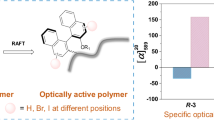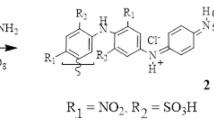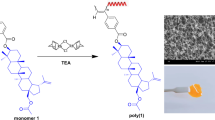Abstract
Novel optically active (S)-2-(3,5-diiodophenyl)oxazoline derivatives ((S)-DIPhROx)) (R=4-benzyl (1a), 4-phenyl (1b)) were synthesized and polymerized using the Sonogashira–Hagihara coupling reaction to obtain the poly(phenylene-ethynylene)s bearing oxazoline derivatives in the weight range from 1060 to 17 300 in 40–72% yields. The polymers were thermally stable up to 220 °C. All the polymers exhibited higher specific rotation values than the model compound did. Moreover, these polymers also showed intense circular dichroism (CD) signals in the transition region of the conjugated main chain, whereas almost no induced Cotton effect was observed for the model compound. The results of the specific rotation and CD and ultraviolet analyses indicate that the optical activities of the polymers arise not only from the configurational chirality of the optically active oxazoline pendant groups but also from elements of higher-order structure such as the helical conformation.
Similar content being viewed by others
Log in or create a free account to read this content
Gain free access to this article, as well as selected content from this journal and more on nature.com
or
References
Yashima, E., Maeda, K., Iida, H., Furusho, Y. & Nagai, K. Helical polymers: synthesis, structures, and functions. Chem. Rev. 109, 6102–6211 (2009).
Okamoto, Y. & Nakano, T. Asymmetric polymerization. Chem. Rev. 94, 349–372 (1994).
Isobe, Y., Onimura, K., Tsutsumi, H. & Oishi, T. Asymmetric polymerization of N-1-naphthylmaleimide with chiral anionic initiator: preparation of highly optically active poly(N-1-naphthylmaleimide). Macromelocules. 34, 7617–7623 (2001).
Zhou, H., Onimura, K., Tsutsumi, H. & Oishi, T. Synthesis and chiroptical properties of (S)-(−)-N-α-methylbenzylmaleimide polymers containing crystallinity. Polym. J. 33, 227–235 (2001).
Yashima, E., Maeda, K. & Furusho, Y. Single-and double-stranded helical polymers: synthesis, structures, and functions. Acc. Chem. Res. 41, 1166–1180 (2008).
Okamoto, Y. Chiral polymers for resolution of enantiomers. J. Polym. Sci. Part A: Polym. Chem. 47, 1731–1739 (2009).
Itsuno, S. Chiral polymer synthesis by means of repeated asymmetric reaction. Prog. Polym. Sci. 30, 540–558 (2005).
Bross, P. A., Schoberl, U. & Daub, J. Carbohydrate-modied conducting polymers synthesis and electrochemistry of sugar-linked azulenes polyazulenes. Adv. Mater. 3, 198–200 (1991).
Gao, H., Isobe, Y., Onimura, K. & Oishi, T. Asymmetric polymerization of (S)-N-maleoyl-L-leucine allyl ester and chiral recognition ability of its polymer as chiral stationary phase for HPLC. Polym. J. 39, 764–776 (2007).
Kaneko, T., Katagiri, H., Umeda, Y., Namikoshi, T., Marwanta, E., Teraguchi, M. & Aoki, T. Optically active helical structure and magnetic interaction of poly(phenylacetylene)-based polyradicals. Polyhedron. 28, 1927–1929 (2009).
Sone, R., Takemura, I., Oyaizu, K. & Nishide, H. Chiral alkylated poly(m-phenylene)s: optical activity and thermal stability of helical structures. Synthetic Met. 159, 925–930 (2009).
Schwartz, E., Koepf, M., Kitto, H. J., Nolte, R. J. M. & Rowan, A. E. Helical poly(isocyanides): past, present and future. Polym. Chem. 2, 33–47 (2011).
Nomura, R., Tabei, J. & Masuda, T. Effect of side chain structure on the conformation of poly(N-propargylalkylamide). Macromolecules 35, 2955–2961 (2002).
Arnt, L. & Tew, G. N. Conformational changes of facially amphiphilic meta-poly(phenylene ethynylene)s in aqueous solution. Macromolecules 37, 1283–1288 (2004).
McQuade, D. T., Pullen, A. E. & Swager, T. M. Conjugated polymer-based chemical sensors. Chem. Rev. 100, 2537–2574 (2000).
Bunz, U. H. F. Poly(aryleneethynylene)s: syntheses, properties, structures, and applications. Chem. Rev. 100, 1605–1644 (2000).
Wang, H. Y., Pu, K. P., Huang, S., Liu, F., Peng, B. & Wei, W. Alternating copolymers based on perylene bisimide and oligo(p-phenyleneethynylene) units: synthesis, characterization, and photoinduced energy and electron transfer processes of a new class of donor–acceptor systems. React. Func. Polym. 69, 117–123 (2009).
Arun, K. G., Mathivanan, P. & Cappiello, J. C2-Symmetric chiral bis(oxazoline)–metal complexes in catalytic asymmetric synthesis. Tetrahedron Asymmetr. 9, 1–45 (1998).
Xi, X., Lou, L., Jiang, L., Sun, W. & Shen, Z. Poly(N-phenylmaleimides) bearing chiral oxazolinyl pendant: supramolecular aggregation and enantioselectivity in fluorescence response. Polymer 49, 2065–2070 (2008).
Xi, X., Jiang, L., Sun, W. & Shen, Z. Metal-induced supramolecular chirality in optically active polymers of oxazoline-substituted N-phenylmaleimides. Chirality 19, 521–527 (2007).
Lu, W., Lou, L., Hu, F., Jiang, L. & Shen, Z. Optically active polyacrylamides bearing an oxazoline pendant: influence of stereoregularity on both chiroptical properties and chiral recognition. J. Polym. Sci. Part A: Polym. Chem. 48, 5411–5418 (2010).
Onimura, K., Shintaku, K., Rattanatraicharoen, P., Yamabuki, K. & Oishi, T. Asymmetric polymerization of chiral 4-benzyl-2-ethynyloxazoline with rhodium catalyst and chiroptical properties of the polymers. Chirality 23 (Suppl 1), E43–E45 (2011).
Endres, A. & Maas, G. Dirhodium(II) tetrakis(perfluoroalkylbenzoates) as partially recyclable catalysts for carbene transfer reactions with diazoacetates. Tetrahedron 58, 3999–4005 (2002).
Abiko, A. & Masamune, S. An improved, convenient procedure for reduction of amino acid to aminoalcohol: use of NaBH4-H2SO4 . Tetrahedron Lett. 33, 5517–5518 (1992).
Liu, R., Sanda, F. & Masuda, T. Synthesis and properties of glutamic acid-derived optically active phenyleneethynylene-based helical polymers. Macromolecules 41, 5089–5097 (2008).
Sonogashira, K., Tohda, Y. & Hagihara, N. A convenient synthesis of acetylenes: catalytic substitutions of acetylenic hydrogen with bromoalkenes, iodoarenes and bromopyridines. Tetrahedron 16, 4467–4470 (1975).
Rossi, R., Carpitaa, A. & Bellinaa, F. Palladium- and/or copper-mediated cross-coupling reactions between 1-aklynes and vinyl, aryl, 1-alkynyl, 1,2-propadienyl, propargyl and allylic halides or related compounds. Org. Prep. Proced. Int. 27, 127–160 (1995).
Shinohara, K., Aoki, T., Kanekoc, T. & Oikawa, E. Syntheses and enantioselective recognition of chiral poly(phenyleneethynylene)s bearing bulky optically active menthyl groups. Polymer 42, 351–355 (2001).
Stone, M. T. & Moore, J. S. A water-soluble m-phenylene ethynylene foldamer. Org. Lett. 4, 469–472 (2004).
Zhao, X. & Schanze, K. S. Meta-linked poly(phenylene ethynylene) conjugated polyelectrolyte featuring a chiral side group: helical folding and guest binding. Langmuir 22, 4856–4862 (2006).
Acknowledgements
We are thankful to Tsuyoshi Tonosaki at Yamaguchi University for performing the X-ray diffraction measurements and for useful comments on this work.
Author information
Authors and Affiliations
Corresponding author
Rights and permissions
About this article
Cite this article
Rattanatraicharoen, P., Yamabuki, K., Oishi, T. et al. Synthesis and characterization of optically active poly(phenylene-ethynylene)s containing chiral oxazoline derivatives. Polym J 44, 224–231 (2012). https://doi.org/10.1038/pj.2011.129
Received:
Revised:
Accepted:
Published:
Issue date:
DOI: https://doi.org/10.1038/pj.2011.129
Keywords
This article is cited by
-
Synthesis and optical properties of biphenylene ethynylene co-polymers and their model compounds
Journal of Chemical Sciences (2015)



